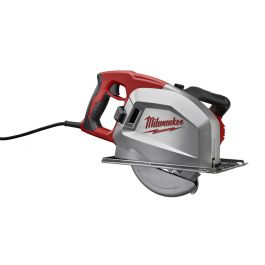Said before, will say again. Try the circular saw on aluminum! The cut quality, is worth the effort! Noise, you can deal with. Wear ear protection, along with adequate eye protection, as always. Table saw or Skil type saw, the cut quality is almost as it would have been if machined. Same with a Router and a template. Super-nice surface finish.Yeah, I hear you trevj. You are right about the proven easy way versus the experimental way. For example:
I tried cutting my 3/16" thick by 3" wide aluminum flat bar using a Bosch jigsaw with a Bosch blade designed for aluminum, and got 3 decent 3" cuts and then the portion of the blade in contact with the aluminum plugged up with aluminum that would not dislodge from it.
A couple of forum members had advised me to use my wood bandsaw with its woodcutting blade, but I had not wanted to create an area-wide aluminum dust coating, nor did I want to hurt the bandsaw blade because changing it is a pain. But, after the jigsaw effort failed, I went ahead and starting cutting on the bandsaw. Like the experienced forum members had said, it worked fine. No loading up of the bandsaw blade (presumably because it stayed cool with its long length compared to the jigsaw blade). And, it was FAST - I did 7 pieces as fast as I could pick them up and feed them through the bandsaw. I did have to vacuum the exterior AND interior of the bandsaw, plus the floor all around it, but it was still the best and fastest solution by far. Not even noisy compared to the jigsaw or what a circular saw would be like (scream city).
So yes, I am listening.
I am realizing that the cost of getting into plasma cutting is not just the cost of the plasma cutter and a consumables supply, but also a larger air compressor that costs way more than the plasma cutter.
But the 10" bandsaw can't do curved cuts on really large pieces, and can't do INSIDE curved cuts at all. The plasma cutter can.
Jim G
The problem you are seeing regarding expensive air compressors, vs inexpensive Plasma cutters, is a recent thing, Plasma cutters used to have a VERY high price of admission, and, comparatively, an adequate Air Compressor, was cheap, and since many, if not all shops, usually had a lot of air tools around anyways, it was usually only a matter of ensuring that the air that reached the Plasma Cutter, was clean and dry.
Practice changing band saw blades, until it is second nature. Should be a one or at most, two minute job. Only slightly longer if you need to weld up a new blade from stock... Seriously. If it's a "pain", and takes you a lot longer than that, either you are looking at it too hard, trying to make a simple job complicated, or you have an unusually PITA saw! The metal cutting bandsaws that I ran at work, have welders on them, so I could break the blade, and thread it through the work, and weld it back together, so as to deal with inside curves and such. That was the intent. Making replacement blades was a happy side effect!

